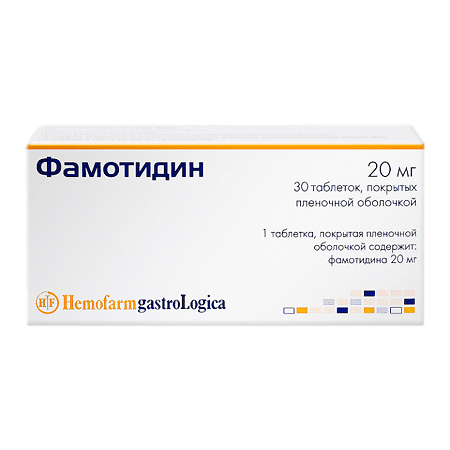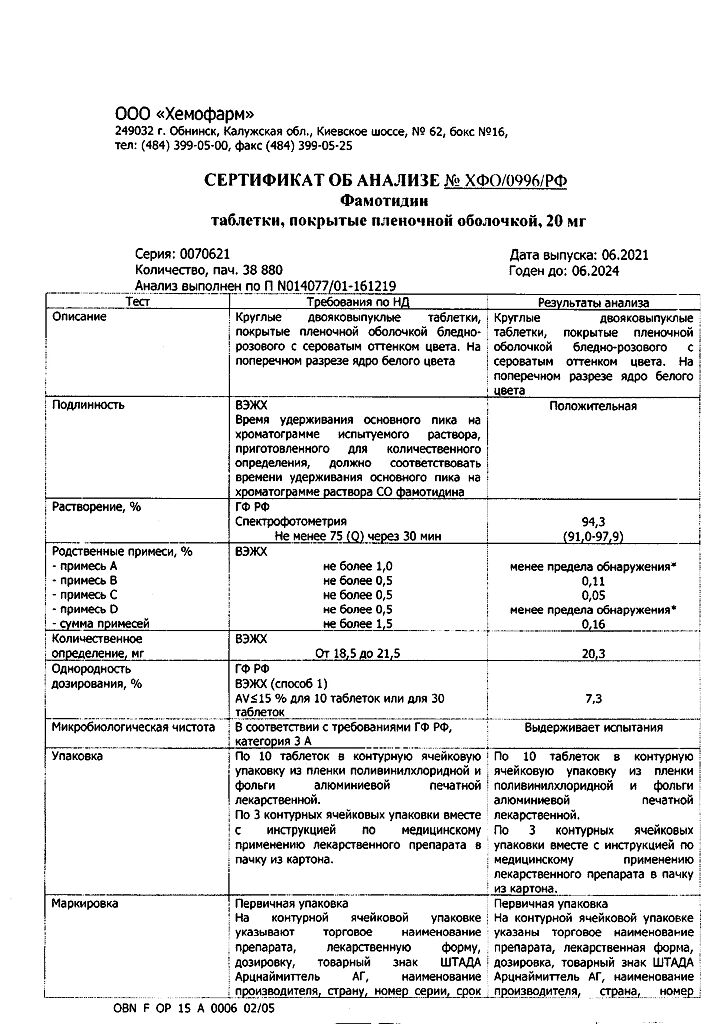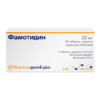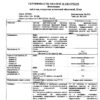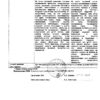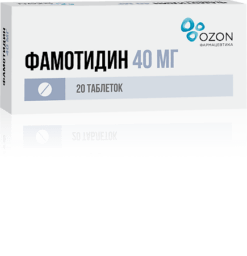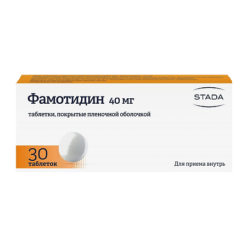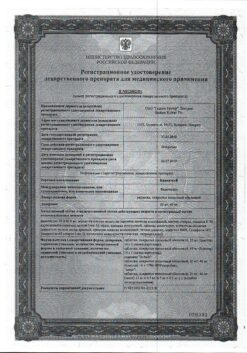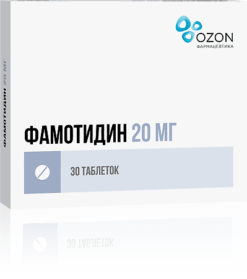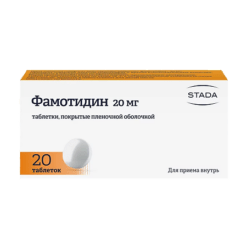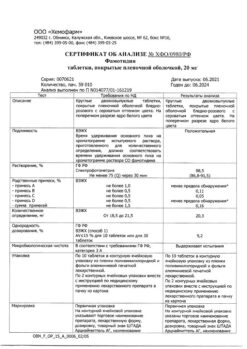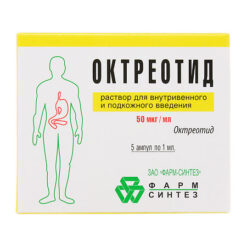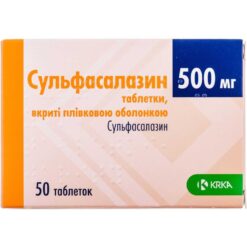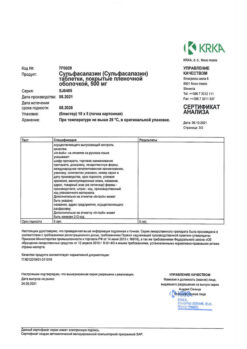No products in the cart.
Famotidine, 20 mg 30 pcs
€2.68 €2.44
EAN: 4607143560437
SKU: 105296
Categories: Medicine, Stomach, intestines, liver, Ulcer and gastritis
Description
Famotidine has an antiulcer effect. Blocker of H2-histamine receptors of III generation.
Inhibits basal and stimulated by histamine, gastrin and acetylcholine production of hydrochloric acid.
Reduces the activity of pepsin. It strengthens the protective mechanisms of the mucous coat of the stomach, promotes the healing of lesions associated with the impact of hydrochloric acid (including scarring of stress ulcers)
and stops gastrointestinal bleeding by increasing the formation of gastric mucus, its content of glycoproteins, stimulation of bicarbonate secretion by the stomach mucosa, the endogenous synthesis of prostaglandins in it and the regeneration rate.
It does not significantly change the plasma level of gastrin. It weakly inhibits cytochrome P450 oxidase system in the liver.
After oral administration the action begins after 1 hour, reaches a maximum within 3 hours. The duration of action of the drug in a single dose depends on the dose and varies from 12 to 24 hours.
Pharmacokinetics
After oral administration it is quickly absorbed from the gastrointestinal tract, the maximum concentration in plasma is reached within 1-3.5 hours.
The bioavailability is 40-45%, it increases with food and decreases with antacids. Binding with plasma proteins is 15-20%.
30-35% of famotidine is metabolized in the liver (with the formation of S-oxide). It penetrates cerebrospinal fluid, passes through the placental barrier and is excreted with breast milk.
Elimination mainly occurs through the kidneys: 27-40% of the drug is excreted unchanged in the urine.
The elimination half-life is 2.5-4 hours; in patients with creatinine clearance lower than 30 ml per minute it increases to 10-12 hours.
In patients with severe renal insufficiency (creatinine clearance below 10 ml/min) the half-life increases to 20 hours.
Indications
Indications
Active ingredient
Active ingredient
Composition
Composition
1 coated tablet contains:
The active ingredients:
Famotidine 20 mg;
Excipients:
Corn starch,
Microcrystalline cellulose,
Silicon dioxide,
Talc,
Magnesium stearate,
Sodium croscarmellose.
The composition of the shell:
Hypromellose,
Macrogol 6000,
Titanium dioxide (E171),
Talk,
Dye iron oxide brown.
How to take, the dosage
How to take, the dosage
Ingestion. Tablets Famotidine should be swallowed without chewing, with plenty of water.
In case of gastric and 12 duodenal ulcer in acute phase, symptomatic gastric and 12 duodenal ulcers (related to NSAID use, stress ulcers, postoperative ulcers), erosive gastroduodenitis usually prescribed 0.02 g 2 times daily or 0.04 g once daily before bedtime.
Interaction
Interaction
Due to the increase in the pH of the stomach contents, concomitant use may reduce absorption of ketoconazole, itraconazole, atazanavir, cefuroxime, dasatinib.
Concomitant use with antacids, sucralfate decreases the intensity of absorption of famotidine.
Inhibits metabolism in the liver of phenazone, aminophenazone, diazepam, hexobarbital, propranololol, metoprolol, lidocaine, phenytoin, theophylline, indirect anticoagulants, glipizide, buformin, metronidazole, caffeine, “slow” calcium channel blockers.
Intensifies absorption of amoxicillin and clavulanic acid.
Concomitant use may increase the serum concentration of saquinavir.
Concomitant use may decrease the serum concentration of fosamprenavir
Medications that depress bone marrow increase the risk of neutropenia.
Special Instructions
Special Instructions
Before starting treatment, the possibility of malignant disease of the esophagus, stomach, or duodenum should be excluded.
Famotidine, like all H2-histamine receptor blockers, should not be abruptly withdrawn (ricochet syndrome).
In long-term treatment in weakened patients with stress, bacterial lesions of the stomach with subsequent spread of infection are possible.
The drug should be taken 2 hours after taking itraconazole, ketoconazole, atazanavir, cefuroxime, dasatinib to avoid significantly reducing their absorption.
A gap between intake of antacids, sucralfate and famotidine should be at least 1-2 hours.
H2-histamine receptor blockers may counteract the effects of pentagastrin and histamine on gastric acid-producing function, so the use of H2-histamine receptor blockers is not recommended in the 24 hours prior to the test.
Histamine H2-histamine receptor blockers may suppress the skin reaction to histamine, resulting in false negatives. (We recommend discontinuing H2-histamine receptor blockers before performing diagnostic skin tests to detect immediate-type allergic skin reactions.)
At the time of treatment, avoid eating foods, drinks, and other medications that may cause gastric mucosal irritation.
Patients with burns may need to increase the dose of the drug due to increased clearance.
The effectiveness of the drug in inhibiting nocturnal gastric acid secretion may be reduced by smoking.
Impact on the ability to drive and operate machinery
With regard to the possibility of side effects on the central nervous system, the question of the possibility of engaging in potentially hazardous activities requiring increased attention
and quick psychomotor reactions should be decided only after assessing the patient’s individual response to the drug.
Contraindications
Contraindications
With caution: hepatic and/or renal insufficiency, cirrhosis with portosystemic encephalopathy (in anamnesis), immunodeficiency, childhood age.
Side effects
Side effects
The digestive system: dry mouth, nausea, vomiting, abdominal pain, rarely – loss of appetite, increased activity of “liver” transaminases, constipation, diarrhea, jaundice, hepatocellular, cholestatic or mixed hepatitis, in some cases may develop acute pancreatitis.
Nervous system disorders: headache, dizziness; asthenia, somnolence, insomnia, anxiety, nervousness, depression, psychosis; there have been described cases of hallucinations, confusion, blurred vision, hyperthermia.
Cardiovascular system disorders: very rarely – decreased blood pressure, bradycardia, atrioventricular block, arrhythmia, vasculitis.
Allergic reactions: skin rash, itching, bronchospasm, angioedema, erythema multiforme, exfoliative dermatitis, Stevens-Johnson syndrome, toxic epidermal necrolysis, anaphylactic shock.
Hematopoietic organs: rarely – neutropenia, leukopenia, thrombocytopenia, hemolytic anemia; in single cases – agranulocytosis, pancytopenia, bone marrow aplasia.
With the reproductive system: in prolonged use of high doses – hyperprolactinemia, gynecomastia, amenorrhea, decreased libido, impotence.
Others: rarely fever, arthralgia, myalgia, tinnitus, dry skin, alopecia.
Overdose
Overdose
Symptoms:
Vomiting, motor agitation, tremor, decreased blood pressure, tachycardia, collapse.
Treatment:
Gastric lavage, symptomatic and supportive therapy, hemodialysis.
Pregnancy use
Pregnancy use
It penetrates through the placenta. Use during pregnancy is possible only if the benefit to the mother exceeds the risk to the fetus.
It penetrates into breast milk; if it is necessary to use during lactation, either discontinue the drug or breastfeed.
Similarities
Similarities
Additional information
| Shelf life | 3 years |
|---|---|
| Conditions of storage | In a place protected from light and moisture, at 15-25 °C |
| Manufacturer | Chemopharm LLC, Russia |
| Medication form | pills |
| Brand | Chemopharm LLC |
Other forms…
Related products
Buy Famotidine, 20 mg 30 pcs with delivery to USA, UK, Europe and over 120 other countries.

